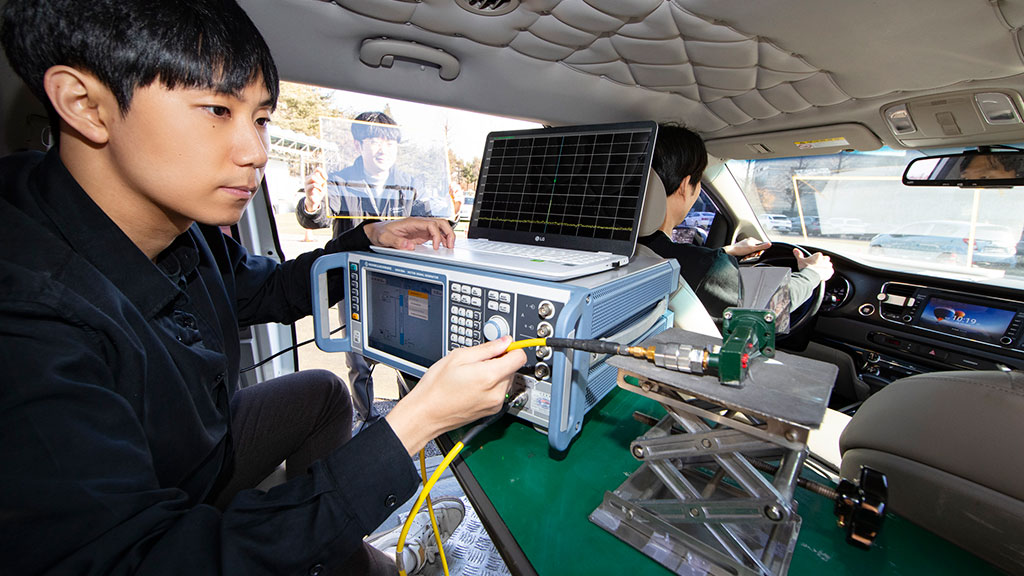KT가 서울대학교 전기·정보공학부 연구팀과 5G 무선 통신 주파수 3.5GHz 대역과 KT스카이라이프 위성 주파수 12GHz 대역에서 동작하는 ‘재구성 가능한 지능형 표면(RIS, Reconfigurable Intelligent Surface) 기술’을 개발했다고 27일 밝혔다.
서울대 연구팀과 ‘재구성 가능한 지능형 표면’ 개발
5G·위성 주파수 대역서 동작…통신 커버리지 개선 가능성
KT가 ‘RIS’를 네트워크 커버리지를 효율적으로 확장할 수 있는 기술로 주목하고 있다.
KT가 서울대학교 전기·정보공학부 연구팀과 5G 무선 통신 주파수 3.5GHz 대역과 KT스카이라이프 위성 주파수 12GHz 대역에서 동작하는 ‘재구성 가능한 지능형 표면(RIS, Reconfigurable Intelligent Surface) 기술’을 개발했다고 27일 밝혔다. KT는 이 기술을 MWC 2024에서 공개했다.
RIS는 전파의 반사와 투과를 원하는 방향으로 유도할 수 있는 기술이다. 건물 외벽에 RIS를 도입하면 무선 통신 장비를 건물 외부로 노출시키지 않고 고주파 대역 주파수를 투과해 신호를 주고받는 것이 가능해진다. 네트워크 인프라를 보다 효율적으로 구축하게 돕는다.
KT와 서울대학교 전기·정보공학부 오정석 교수 연구팀과 개발한 RIS는 6G 후보 주파수 외에도 5G 무선 통신 주파수와 KT스카이라이프 위성 주파수 대역을 작은 면적으로 통과해주는 것이 특징이다.
KT는 밀리미터파(mmWave) 대역인 28GHz 대역을 시작으로 6G 후보 주파수 대역인 8GHz, 15GHz 대역에서 동작하는 RIS 소재와 기술을 개발해왔다. 현재 5G에서 사용하고 있는 주파수 대역은 상대적으로 낮은 주파수를 사용하기 때문에 RIS 시료의 면적이 커져야 하는 문제 등으로 상용화 가능성이 낮았다.
이번에 개발된 RIS는 새로운 표면 설계 기술과 구조를 활용해 진행 방향 대비 90도 이상으로 굴절(음의 굴절 각도)되는 넓은 투과 각도와 높은 투과율을 동시에 확보한다. 전파 투과 각도가 넓으면 실내 무선 품질을 높이는데 유리하다. 투명 소재로 제작돼 이동체 유리창에 부착하거나 일체형으로 제작이 가능해 쉽게 설치할 수 있다.
KT와 서울대학교는 자체 RIS 기술의 범용성을 검증하기 위해 차량 유리창에 RIS를 부착하고 고속도로 외곽의 통신 타워의 5G 전파나 KT스카이라이프 위성 신호와 같이 차량 이동 방향의 수직 방향에서 인입되는 무선 신호가 내부로 굴절되는 것을 확인했다.
KT는 이번에 확보한 RIS 기술을 건물 창문이나 차량 창문에 적용할 수 있도록 장비 제조사, 소재·부품 회사와 협력을 지속한다. 또한 RIS와 같이 다양한 무선 네트워크 환경에 적용 가능한 요소기술을 지속 발굴해 6G 무선 통신 분야 기술 리더십을 확보할 계획이다.
서울대학교 전기·정보공학부 오정석 교수는 “기존 투명 RIS에 대한 연구 및 시연이 대부분 투과 손실 개선에만 집중된 반면 본 RIS 기술 및 검증은 투명 소재와 공정 조건의 제약에서도 전파를 임의의 방향으로 굴절시켜 통신 커버리지가 크게 개선될 수 있음을 처음으로 증명하였다는 점에서 중요한 의미가 있다”고 전했다.
KT 네트워크연구소장 이종식 상무는 "이번에 개발한 RIS 기술은 이동체 내부 무선 서비스 품질 향상에 기대한다"라며 "새로운 무선 통신 기술에 대한 리더십을 강화해 6G 네트워크 구축에 기여할 것”이라고 말했다.
